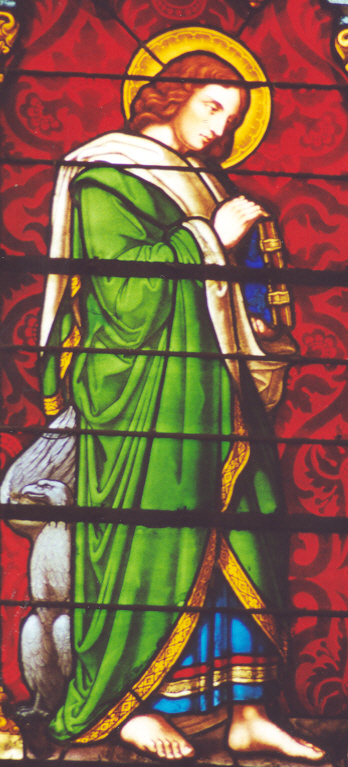
John 20:19-31
B-Cycle
Believing Is Seeing by Rev. Jerome Magat
Reprinted with permission of "The Arlington Catholic
Herald"
Home Page
To Sunday Gospel Reflections Index
John wrote to show that Christ was
the Messiah, the Divine Son of God.

On the evening of that first day of the week, when the doors were locked, where the disciples were, for fear of the Jews, Jesus came and stood in their midst and said to them, "Peace be with you." When he had said this, he showed them his hands and his side. The disciples rejoiced when they saw the Lord. Jesus said to them again, "Peace be with you. As the Father has sent me, so I send you." And when he had said this, he breathed on them and said to them, "Receive the Holy Spirit. Whose sins you forgive are forgiven them, and whose sins you retain are retained."
Thomas, called Didymus, one of the Twelve, was not with them when Jesus came. So the other disciples said to him, "We have seen the Lord." But he said to them, "Unless I see the mark of the nails in his hands and put my finger into the nail marks and put my hand into his side, I will not believe."
Now a week later his disciples were again inside and Thomas was with them. Jesus came, although the doors were locked, and stood in their midst and said, "Peace be with you." Then he said to Thomas, "Put your finger here and see my hands, and bring your hand and put it into my side, and do not be unbelieving, but believe." Thomas answered and said to him, "My Lord and my God!" Jesus said to him, "Have you come to believe because you have seen me? Blessed are those who have not seen and have believed."
Now Jesus did many other signs in the presence of his disciples that are not written in this book. But these are written that you may come to believe that Jesus is the Christ, the Son of God, and that through this belief you may have life in his name.
The story of St. Thomas the Apostle or Doubting Thomas is not unfamiliar to us. When Jesus appears to the Apostles a week after the Resurrection, our Lord challenges Thomas in his unbelief and brings him to incredulous adoration. Thomas is moved to say, "My Lord and my God." Just a week earlier, Thomas had said that he would not believe unless He had seen the risen Lord physically. When our Lord appears to the Apostles on the Sunday after Easter, he turns Thomas' idea on its head. Our Lord states that, "Blessed are those who have not seen and have believed," meaning that those who have not seen the Lord physically but believe in him are blessed. It is clear that our faith in Jesus is based on the testimony of eyewitnesses.
This has been the story of the Church from her inception. The Catholic faith is built upon the testimony of St. Peter and the Apostles, with Jesus Christ at its center. Our faith is not an abstract set of ideas or propositions. It is not a philosophy, as some would suggest. Rather, the Catholic faith is incarnation, rooted in revelation. The transmission of this faith relies on the testimony of those who walked with the Lord during his brief life here on earth. The Gospels themselves are testimonies of faith, written by those who either personally knew the Lord or used eyewitnesses as their primary source.
For Thomas, seeing was believing. For us, however, the opposite is true - believing is seeing. Barring those saints who have been gifted with ecclesiastically-approved apparitions, none of us have seen Jesus in a physically-recognizable form. Therefore, our response to Christ is made in faith. It is our eyes of faith that allow us to see Jesus in ways beyond the limitations of physical sight. This is especially true when we come into the presence of the Eucharist. Christ's presence remains hidden under the veil of sacramental elements but it is our belief that allows us to truly see him and acknowledge his body, blood, soul and divinity really and substantially present. Our physical sight fails us but our sight by faith allows us to penetrate the hidden mysteries contained in this most sublime sacrament. This dynamic is also at work in the sacrament of penance. The absolution given by the priest invites us to believe that our sins have been forgiven, even though physical sight cannot detect the cleansing of sins. Again, it is faith that allows us to see beyond what mere physical sight can render.
St. Anselm of Canterbury once wrote, "Credo ut intelligam," which means "I believe so that I may understand." This must be the disposition of any authentic disciple of the Lord Jesus. The first move is God infusing the virtue of faith into our souls at baptism. The second move is our response in faith, actualizing the potency of this virtue. The third move is allowing our eyes of faith to penetrate the mysteries of God more profoundly through the intellect and free will that he gave us in the first place. Like St. Anselm, may we better understand that believing means truly seeing with the eyes of faith.
Please consider a tax deductible gift to support this web site.
Home Page
Top
To
Sunday Gospel Reflections Index